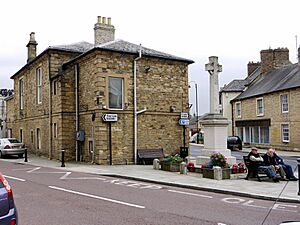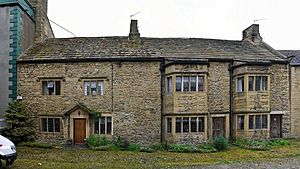Wolsingham facts for kids
Quick facts for kids Wolsingham |
|
|---|---|
 Wolsingham Town Hall |
|
| Population | 2,720 (2011) |
| OS grid reference | NZ075375 |
| Unitary authority | |
| Ceremonial county | |
| Region | |
| Country | England |
| Sovereign state | United Kingdom |
| Post town | Bishop Auckland |
| Postcode district | DL13 |
| Dialling code | 01388 |
| Police | Durham |
| Fire | County Durham and Darlington |
| Ambulance | North East |
| EU Parliament | North East England |
| UK Parliament | |
Wolsingham is a lively market town located in Weardale, County Durham, England. It sits right by the River Wear, nestled between the towns of Crook and Stanhope. It's a great place with a long history!
Contents
A Glimpse into Wolsingham's Past
Wolsingham is found where the River Wear meets the Waskerley Beck. It's one of the oldest market towns in County Durham. Its name might come from an old Germanic family called the Waelsingas, or from a person's name, "Wolfsige." The first mention of Wolsingham was around 1120 AD. A saint named Godric lived here for nearly two years with a hermit named Elric.
Life in Early Wolsingham
Long ago, Wolsingham was a busy community. People worked hard on the land. There were shepherds, plough-makers, and beekeepers. Forest keepers, wood turners, and carters also lived here. They grew food for themselves and supplied the Bishop's Castle. The bishop and his friends enjoyed hunting red deer in the nearby forests. These forests were huge, second only to the New Forest in England!
Historic Buildings and Royal Visitors
The oldest homes in Wolsingham are at Whitfield Place on Front Street. Three cottages there are very old. The one on the left is from 1677. Other buildings here are even older. They used to be the Pack Horse Inn. It's said that Edward III might have stayed there in 1327. He was returning from a trip to Scotland. Another king, Charles II, is rumored to have ridden his horse up the internal staircase of a house in the 1600s!
The Market Town's Importance
In 1615, Wolsingham was given permission to hold a market. This was a big deal! In 1667, this right was confirmed. A special piece of land was set aside for the market. This market was very important for the area. People could buy many things there. There were looms in town, making table linens and clothes. Traders from Yorkshire and Newcastle upon Tyne came to sell their goods. Hat makers from Hexham and Barnard Castle also visited. You could even find spices and gingerbread!
Religious History in Wolsingham
Wolsingham has a rich religious history. A memorial marks where a Roman Catholic priest, John Duckett, was arrested in 1644. He was later executed in London. The town has a Roman Catholic church and a former convent. There are also large Church of England, Baptist, and Methodist groups.
John Wesley, who helped start the Methodist Church, visited Weardale many times. He preached in Wolsingham several times between 1764 and 1790. He often spoke from a stone pulpit behind Whitfield House. The first Methodist meeting house was built in 1776. Two more chapels were built later. A Wesleyan school opened in 1856. Many people came from the valley, especially when the steelworks opened.
Wolsingham Grammar School: A Legacy of Learning
Wolsingham Grammar School started in 1614. A new building opened in 1911. Today, it's part of a larger school. A new part was built from 2014 to 2015. The Duke of Gloucester opened it in 2016.
The school also has the oldest World War memorials in the country. Trees around the field near the Bell Tower are special. Each tree was planted by the Head Teacher. They honor students who died in the wars. Students and staff hold a service every Remembrance Day. They remember those who bravely served.
Wolsingham Town Hall, in the Market Place, was finished in 1824. It's a key building in the town.
The Rise and Fall of the Steelworks
The Victorian businessman Charles Attwood built an ironworks here. It opened in 1864 and became a major employer. The works made steel from local iron ore. They produced steel parts for shipbuilding and weapons. These were very important industries in the North East. The factory helped a lot during both World Wars. Electric furnaces were added around 1950. However, business slowed down, and the works closed in 1984. A smaller worker-run company kept it going for a while. But it finally closed for good in 2008. The site was cleared in 2009. There are plans to develop the area in the future.
Holywood Hall: From Home to Hospital
Charles Attwood also built his home, Holywood Hall, on the north hillside. After he died, it became a hospital. It was a special hospital for treating tuberculosis. By the 1960s, there were fewer cases of this illness. So, the hospital started caring for elderly patients. These patients came from another hospital. They were older people with memory problems. They had no family to care for them. When the hospital closed, it was turned into four homes. The land around the hall was also used for luxury houses.
Culture and Community Life
Wolsingham is known for its strong community spirit. There are many events and activities that bring people together.
Wolsingham Agricultural Show
The Wolsingham Agricultural Society hosts its yearly show. It happens on the first weekend of September. More than 30,000 people attend each day! This show started in 1763. It's one of the oldest shows in the country. Animals and visitors come from all over. A funfair is also held in town that weekend. Many streets are closed to traffic because of the large crowds.
The Weardale Railway: A Journey Through Time
Wolsingham is served by the historic Weardale Railway. This special railway runs to Stanhope. It even has steam train services! The railway was first built in 1847. It was closed to passengers in 1953. It continued to carry goods until 1993. After a lot of work, the heritage railway reopened in 2010. A special train even ran directly from London Kings Cross!
The Weardale Railway also used to transport coal. Up to 150,000 tonnes of high-quality coal were moved each year. This coal came from a mine about 4 miles away. A new loading facility opened in Wolsingham in 2011. Some people in the area were against the coal depot. But permission was given because the lorries avoided the town. Trains carried the coal to a steelworks. This kept Wolsingham's connection to steel making alive. This coal transport stopped in 2015.
Education in Wolsingham
Wolsingham has two schools for its young people:
- Wolsingham Primary School, for children aged 5 to 11.
- Wolsingham School, which serves older students.
Media and Local News
Residents of Wolsingham get their news and TV from several sources.
- Local television is provided by BBC North East and Cumbria and ITV Tyne Tees.
- TV signals come from the Pontop Pike TV transmitter. There is also a local relay transmitter.
- Local radio stations include BBC Radio Newcastle, Capital North East, Heart North East, Smooth North East, Sun FM, Greatest Hits Radio North East, and Bishop FM. Bishop FM is a community station from Bishop Auckland.
- The local newspaper serving the town is The Northern Echo.
Famous People from Wolsingham
Wolsingham has been home to some notable individuals:
- Janet Taylor: An amazing astronomer, navigation expert, mathematician, and meteorologist.
- Bridget Atkinson: A farmer and shell collector. She gathered shells from all over the world! She was the first honorary member of the Society of Antiquaries of Newcastle upon Tyne.



